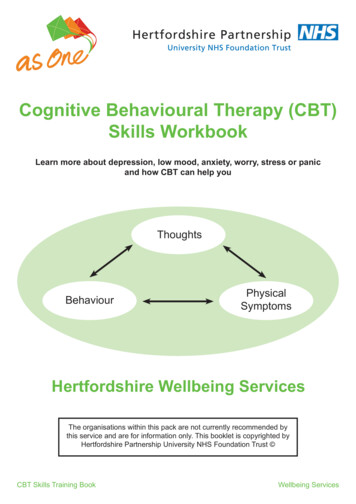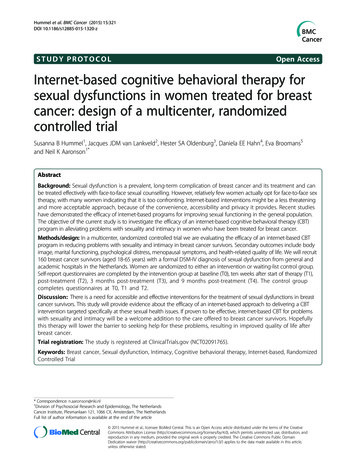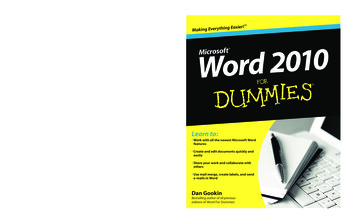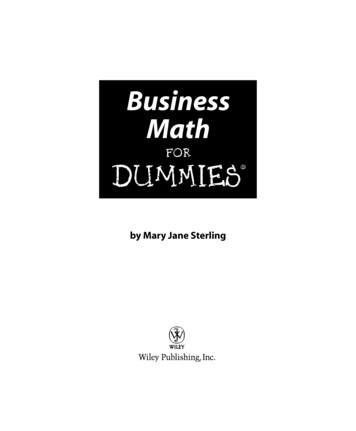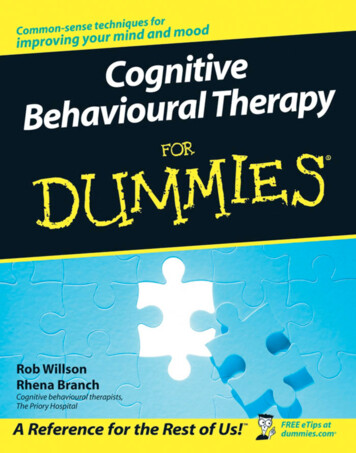
Transcription
CognitiveBehavioural TherapyFORDUMmIES‰by Rob Willson and Rhena Branch
CognitiveBehavioural TherapyFORDUMmIES‰
CognitiveBehavioural TherapyFORDUMmIES‰by Rob Willson and Rhena Branch
Cognitive Behavioural Therapy For Dummies Published byJohn Wiley & Sons, LtdThe AtriumSouthern GateChichesterWest SussexPO19 8SQEnglandE-mail (for orders and customer service enquires): cs-books@wiley.co.ukVisit our Home Page on www.wiley.comCopyright 2006 John Wiley & Sons, Ltd, Chichester, West Sussex, EnglandPublished by John Wiley & Sons, Ltd, Chichester, West SussexAll Rights Reserved. No part of this publication may be reproduced, stored in a retrieval system or transmitted in any form or by any means, electronic, mechanical, photocopying, recording, scanning or otherwise,except under the terms of the Copyright, Designs and Patents Act 1988 or under the terms of a licenceissued by the Copyright Licensing Agency Ltd, 90 Tottenham Court Road, London, W1T 4LP, UK, without thepermission in writing of the Publisher. Requests to the Publisher for permission should be addressed to theLegal Department, Wiley Publishing, Inc, 10475 Crosspoint Blvd, Indianapolis, Indiana 46256, United States,317-572-4355, fax 317-572-4355, or online at http://www.wiley.com/go/permissions.Trademarks: Wiley, the Wiley Publishing logo, For Dummies, the Dummies Man logo, A Reference for theRest of Us!, The Dummies Way, Dummies Daily, The Fun and Easy Way, Dummies.com and related tradedress are trademarks or registered trademarks of John Wiley & Sons, Inc. and/or its affiliates in the UnitedStates and other countries, and may not be used without written permission. All other trademarks are theproperty of their respective owners. Wiley Publishing, Inc., is not associated with any product or vendormentioned in this book.LIMIT OF LIABILITY/DISCLAIMER OF WARRANTY: THE CONTENTS OF THIS WORK ARE INTENDED TOFURTHER GENERAL SCIENTIFIC RESEARCH, UNDERSTANDING, AND DISCUSSION ONLY AND ARE NOTINTENDED AND SHOULD NOT BE RELIED UPON AS RECOMMENDING OR PROMOTING A SPECIFICMETHOD, DIAGNOSIS, OR TREATMENT BY PHYSICIANS FOR ANY PARTICULAR PATIENT. THE PUBLISHER AND THE AUTHOR MAKE NO REPRESENTATIONS OR WARRANTIES WITH RESPECT TO THEACCURACY OR COMPLETENESS OF THE CONTENTS OF THIS WORK AND SPECIFICALLY DISCLAIM ALLWARRANTIES, INCLUDING WITHOUT LIMITATION ANY IMPLIED WARRANTIES OF FITNESS FOR A PARTICULAR PURPOSE. IN VIEW OF ONGOING RESEARCH, EQUIPMENT MODIFICATIONS, CHANGES INGOVERNMENTAL REGULATIONS, AND THE CONSTANT FLOW OF INFORMATION RELATING TO THE USEOF MEDICINES, EQUIPMENT, AND DEVICES, THE READER IS URGED TO REVIEW AND EVALUATE THEINFORMATION PROVIDED IN THE PACKAGE INSERT OR INSTRUCTIONS FOR EACH MEDICINE, EQUIPMENT, OR DEVICE FOR, AMONG OTHER THINGS, ANY CHANGES IN THE INSTRUCTIONS OR INDICATION OF USAGE AND FOR ADDED WARNINGS AND PRECAUTIONS. READERS SHOULD CONSULT WITHA SPECIALIST WHERE APPROPRIATE. THE FACT THAT AN ORGANISATION OR WEBSITE IS REFERREDTO IN THIS WORK AS A CITATION AND/OR A POTENTIAL SOURCE OF FURTHER INFORMATION DOESNOT MEAN THAT THE AUTHOR OR THE PUBLISHER ENDORSES THE INFORMATION THE ORGANISATION OR WEBSITE MAY PROVIDE OR RECOMMENDATIONS IT MAY MAKE. FURTHER, READERSSHOULD BE AWARE THAT INTERNET WEBSITES LISTED IN THIS WORK MAY HAVE CHANGED OR DISAPPEARED BETWEEN WHEN THIS WORK WAS WRITTEN AND WHEN IT IS READ. NO WARRANTY MAYBE CREATED OR EXTENDED BY ANY PROMOTIONAL STATEMENTS FOR THIS WORK. NEITHER THEPUBLISHER NOR THE AUTHOR SHALL BE LIABLE FOR ANY DAMAGES ARISING HEREFROM.Wiley also publishes its books in a variety of electronic formats. Some content that appears in print maynot be available in electronic books.British Library Cataloguing in Publication Data: A catalogue record for this book is available from theBritish Library.ISBN-13: 978-0-470-01838-5 (PB)ISBN-10: 0-470-01838-0 (PB)Printed and bound in Great Britain by Bell and Bain Ltd, Glasgow10 9 8 7 6 5 4 3 2 1
About the AuthorsRob Willson, BSc, MSc, Dip SBHS, has worked for the Priory Hospital NorthLondon for a number of years as a CBT therapist. Rob also teaches andsupervises trainee therapists at Goldsmith’s College, University of London,and has his own practice in North London. His first book was OvercomingObsessive Compulsive Disorder (Constable & Robinson, 2005), co-written withDr David Veale.Rob has done numerous newspaper and radio interviews about CBT. Morerarely he’s appeared on television discussing understanding and treating bodyimage problems. His particular interests include the research and treatment ofobsessional problems, and applying CBT in group and self-help formats.Rhena Branch, MSc, Dip CBT, is an accredited CBT therapist and workswith the Priory Hospital North London as a CBT therapist. She also has herown practice in North London and supervises on the Masters’ course atGoldsmith College, University of London.
DedicationTo our children, Felix, Atticus, Emma, and Lucy.Authors’ AcknowledgementsFrom Rob: I’m hugely grateful to Rhena for agreeing to write this book withme, and thereby making the process substantially more entertaining. Thankyou Rhena for your intelligent and hard working attitude, sharp wit, and consistently good company. A great deal of gratitude is due to my family andfriends who have been more than patient with my absences whilst writingthis book.From Rhena: First and foremost I’d like to thank Rob for inviting me to coauthor the book. Also, thank you Rob for your support with my clinical workand for good solid supervision in the not so distant past (and mostly I appreciate your unerring sense of humour and your friendship!). Hal, for lookingafter the boys. And, last but never least, thanks to my tabby cat Jack (whoharbours grandiose ideas of being an ocelot), for providing Rob and myselfwith hours of entertainment at his expense.From both of us: So many researchers, therapists, and authors deserveacknowledgement for influencing our understanding and practice of CBT, andtherefore the content of this book. Founding fathers Albert Ellis and Aaron T.Beck deserve special mention of course, but there are many, many others, suchas (in no particular order): Ray DiGuiseppe, Mary-Anne Layden, JaquelinePersons, David A Clarke, Adrian Wells, Paul Salkovskis, Christine Padesky,David Burns, Kevin Gournay, Stanley Rachman, David Veale, and David M.Clarke. Special acknowledgment is due to Windy Dryden for teaching us somuch and teaching us well.Finally thanks to all our patients (clients!), past and present, for letting us getto know you and learn from you.
Publisher’s AcknowledgementsWe’re proud of this book; please send us your comments through our Dummies online registrationform located at www.dummies.com/register/.Some of the people who helped bring this book to market include the following:Acquisitions, Editorial, andMedia DevelopmentProject Editor: Rachael ChilversComposition ServicesProject Coordinator: Maridee EnnisDevelopment Editor: Brian KramerLayout and Graphics: Carl Byers, Andrea Dahl,Denny Hager, Joyce Haughey, Heather RyanContent Editor: Simon BellProofreader: Susan MoritzCopy Editor: Colette HoldenIndexer: TECHBOOKS Production ServicesProofreader: Juliet BookerTechnical Editor: David Kingdon, Professor ofMental Health Care Delivery, University ofSouthamptonExecutive Editor: Jason DunneExecutive Project Editor:Amie Jackowski TibbleCover Photo: Ray Massey/Image Bank/GettyImagesCartoons: Rich Tennant,www.the5thwave.comSpecial Help: Zoë WykesPublishing and Editorial for Consumer DummiesDiane Graves Steele, Vice President and Publisher, Consumer DummiesJoyce Pepple, Acquisitions Director, Consumer DummiesKristin A. Cocks, Product Development Director, Consumer DummiesMichael Spring, Vice President and Publisher, TravelKelly Regan, Editorial Director, TravelPublishing for Technology DummiesAndy Cummings, Vice President and Publisher, Dummies Technology/General UserComposition ServicesGerry Fahey, Vice President of Production ServicesDebbie Stailey, Director of Composition Services
Contents at a GlanceIntroduction .1Part I: Introducing CBT Basics.7Chapter 1: You Feel the Way You Think.9Chapter 2: Spotting Errors in Your Thinking .19Chapter 3: Tackling Toxic Thoughts .39Chapter 4: Behaving like a Scientist: Designing andConducting Behavioural Experiments .49Chapter 5: Pay Attention! Refocusing and Retraining Your Awareness.61Part II: Charting the Course: Defining Problemsand Setting Goals .71Chapter 6: Exploring Emotions.73Chapter 7: Identifying Solutions That Cause You Problems .95Chapter 8: Setting Your Sights on Goals .107Part III: Putting CBT into Action.117Chapter 9: Standing Up to Anxiety and Facing Fear.119Chapter 10: Deconstructing and Demolishing Depression .129Chapter 11: Overcoming Obsessions.143Chapter 12: Overcoming Low Self-esteem by Accepting Yourself .159Chapter 13: Cooling Down Your Anger .175Part IV: Looking Backwards and Moving Forwards .189Chapter 14: Taking a Fresh Look at Your Past .191Chapter 15: Moving New Beliefs from Your Head to Your Heart .209Chapter 16: Heading for a Healthier and Happier Life.223Chapter 17: Overcoming Obstacles to Progress.233Chapter 18: Psychological Gardening: Maintaining Your CBT Gains.243Chapter 19: Working with the Professionals .253Part V: The Part of Tens .265Chapter 20: Ten Healthy Attitudes for Living .267Chapter 21: Ten Self-Esteem Boosters That Don’t Work .275Chapter 22: Ten Ways to Lighten Up.281Chapter 23: Ten Books to Add to Your Library .289
Appendix A: Resources .293Appendix B: Forms.297Index .309
Table of ContentsIntroduction.1About This Book.1Conventions Used in This Book .2What You’re Not to Read.2Foolish Assumptions .3How This Book Is Organised.3Part I: Introducing CBT Basics.3Part II: Charting the Course: Defining Problemsand Setting Goals .3Part III: Putting CBT into Action .4Part IV: Looking Backwards and Moving Forwards .4Part V: The Part of Tens.5Appendixes.5Icons Used in This Book.5Where to Go from Here.6Part I: Introducing CBT Basics .7Chapter 1: You Feel the Way You Think . . . . . . . . . . . . . . . . . . . . . . . . . . .9Using Scientifically Tested Methods.9Understanding CBT.11Combining science, philosophy, and behaviour .11Progressing from problems to goals .12Making the Thought–Feeling Link .12Emphasising the meanings you attach to events.13Acting out .13Learning Your ABCs .14Characterising CBT .16Chapter 2: Spotting Errors in Your Thinking . . . . . . . . . . . . . . . . . . . . . .19Catastrophising: Turning Mountains Back Into Molehills.20All-or-Nothing Thinking: Finding Somewhere in Between .21Fortune-telling: Stepping Away from the Crystal Ball.23Mind-Reading: Taking Your Guesses with a Pinch of Salt .24Emotional Reasoning: Reminding Yourself That FeelingsAren’t Facts .26Overgeneralising: Avoiding the Part/Whole Error .27Labelling: Giving Up the Rating Game .28Making Demands: Thinking Flexibly .30Mental Filtering: Keeping an Open Mind.31
xiiCognitive Behavioural Therapy For DummiesDisqualifying the Positive: Keeping the Baby When Throwing Outthe Bathwater .33Low Frustration Tolerance: Realising You Can Bear the ‘Unbearable’.34Personalising: Removing Yourself from the Centre of the Universe.35Chapter 3: Tackling Toxic Thoughts . . . . . . . . . . . . . . . . . . . . . . . . . . . . .39Catching NATs.39Making the thought–feeling link .40Becoming more objective about your thoughts.40Stepping Through the ABC Form I .40Creating Constructive Alternatives: Completing the ABC Form II.44Chapter 4: Behaving like a Scientist: Designing and ConductingBehavioural Experiments . . . . . . . . . . . . . . . . . . . . . . . . . . . . . . . . . . . . . .49Seeing for Yourself: Reasons for Doing Behavioural Experiments .50Testing Out Predictions.50Seeking Evidence to See Which Theory Best Fits the Facts .53Conducting Surveys.55Making Observations.57Ensuring Successful Behavioural Experiments .57Keeping Records of Your Experiments.58Chapter 5: Pay Attention! Refocusing and RetrainingYour Awareness . . . . . . . . . . . . . . . . . . . . . . . . . . . . . . . . . . . . . . . . . . . . . .61Training in Task Concentration .62Choosing to concentrate .62Tuning in to tasks and the world around you.65Tackling the task concentration record sheet .66Becoming More Mindful .68Being present in the moment.68Letting your thoughts pass by.68Discerning when not to listen to yourself .69Incorporating mindful daily tasks .70Part II: Charting the Course: Defining Problemsand Setting Goals.71Chapter 6: Exploring Emotions . . . . . . . . . . . . . . . . . . . . . . . . . . . . . . . . .73Naming Your Feelings .74Thinking What to Feel.75Understanding the Anatomy of Emotions.76Comparing Healthy and Unhealthy Emotions .77Spot the difference in thinking .86Spot the difference in behaving, and ways you want to behave .88Spot the difference in what you focus on.89Spotting Similarities in Your Physical Sensations.90
Table of ContentsIdentifying Feelings about Feelings.91Defining Your Emotional Problems .92Making a statement .92Rating your emotional problem.93Chapter 7: Identifying Solutions That Cause You Problems . . . . . . . .95When Feeling Better Can Make Your Problems Worse.95Getting Over Depression Without Getting Yourself Down .97Loosening Your Grip on Control .97Feeling Secure in an Uncertain World.98Surmounting the Side Effects of Excessive Safety-Seeking .100Wending Your Way Out of Worry.102Preventing the Perpetuation of Your Problems .103Helping Yourself: Putting the Petals on Your Vicious Flower.104Chapter 8: Setting Your Sights on Goals . . . . . . . . . . . . . . . . . . . . . . . .107Putting SPORT Into Your Goals .107Homing In on How You Want to Be Different .108Setting goals in relation to your current problems.109Making a statement .110Maximising Your Motivation.110Identifying inspiration for change .110Focusing on the benefits of change .111Completing a cost–benefit analysis .111Recording your progress .113Part III: Putting CBT into Action .117Chapter 9: Standing Up to Anxiety and Facing Fear . . . . . . . . . . . . . .119Acquiring Anti-Anxiety Attitudes .119Thinking realistically about the probability of bad events.119Avoiding extreme thinking .120Taking the fear out of fear .120Attacking Anxiety .122Winning by not fighting .122Defeating fear with FEAR .122Repeatedly confronting your fears .123Keeping your exposure challenging but not overwhelming .123Shedding safety behaviours.125Recording your fear-fighting .125Overriding Common Anxieties .125Socking it to social anxiety.126Waging war on worry .126Pounding on panic .126Assaulting agoraphobia.127Dealing with post-traumatic stress disorder .127Hitting back at fear of heights.127xiii
xivCognitive Behavioural Therapy For DummiesChapter 10: Deconstructing and Demolishing Depression . . . . . . . .129Understanding the Nature of Depression .130Looking at What Fuels Depression.131Going Round and Round in Your Head: Ruminative Thinking.132Catching yourself in the act .133Arresting ruminations before they arrest you.134Activating Yourself as an Antidepressant .135Tackling inactivity .135Dealing with the here and now: Solving problems.136Taking care of yourself and your environment.138Getting a Good Night’s Sleep .138Setting realistic sleep expectations .139Making your bedroom oh so cosy.140Managing Suicidal Thoughts.141Chapter 11: Overcoming Obsessions . . . . . . . . . . . . . . . . . . . . . . . . . . .143Identifying and Understanding Obsessional Problems .144Understanding obsessive-compulsive disorder (OCD) .145Recognising health anxiety .146Understanding body dysmorphic disorder (BDD).147Identifying Unhelpful Behaviours .149Acquiring Anti-obsessional Attitudes.149Tolerating doubt and uncertainty .150Trusting your judgement.150Treating your thoughts as nothing more than thoughts.151Being flexible and not trying too hard.151Using external and practical criteria .152Allowing your mind and body to do their own things.152Normalising physical sensations and imperfections.153Facing Your Fears: Reducing (And Stopping) Rituals.153Resist! Resist! Resist!.154Delaying and modifying rituals.154Being Realistic about Responsibility .155Dividing up your responsibility pie.155Retraining your attention .157Chapter 12: Overcoming Low Self-esteemby Accepting Yourself . . . . . . . . . . . . . . . . . . . . . . . . . . . . . . . . . . . . . . . .159Identifying Issues of Self-Esteem .159Developing Self-Acceptance.160Understanding that you have worth because you’re human .161Appreciating that you’re too complex to globallymeasure or rate.161Acknowledging your ever-changing nature .163Accepting your fallible nature .165Valuing your uniqueness .165Using self-acceptance to aid self-improvement.166Understanding that acceptance doesn’t mean giving up.168
Table of ContentsBeing Inspired to Change .168Actioning Self-Acceptance .170Self-talking your way to self-acceptance .170Following the best-friend argument .171Dealing with doubts and reservations.172Selecting the Self-help Journey to Self-Acceptance .173Chapter 13: Cooling Down Your Anger . . . . . . . . . . . . . . . . . . . . . . . . .175Discerning the Difference between Healthy and Unhealthy Anger .175Key characteristics of unhealthy anger.176Hallmarks of healthy anger .177Assembling Attitudes That Underpin Healthy Anger .178Putting up with other people.179Forming flexible preferences .180Accepting other people as fallible human beings .181Accepting yourself .182Developing high frustration tolerance.182Pondering the pros and cons of your temper.183Imparting Your Indignation in a Healthy Way.184Asserting yourself effectively .184Coping with criticism.185Using the disarming technique.186Dealing with Difficulties in Overcoming Anger .187Part IV: Looking Backwards and Moving Forwards.189Chapter 14: Taking a Fresh Look at Your Past . . . . . . . . . . . . . . . . . . .191Exploring How Your Past Can Influence Your Present .191Identifying Your Core Beliefs .192The three camps of core beliefs .194Seeing how your core beliefs interact .195Detecting Your Core Beliefs .195Following a downward arrow.195Picking up clues from your dreaming and screaming .196Tracking themes .197Filling in the blanks .197Understanding the Impact of Core Beliefs .198Spotting when you are acting according to old rulesand beliefs .198Understanding that unhealthy core beliefs makeyou prejudiced .199Making a Formulation of Your Beliefs.200Limiting the Damage: Being Aware of Core Beliefs .203Developing Alternatives to Your Core Beliefs .204Revisiting history .205Starting from scratch .207xv
xviCognitive Behavioural Therapy Fo
Cognitive Behavioural Therapy For Dummies Published by John Wiley & Sons, Ltd The Atrium Southern Gate Chichester West Sussex PO19 8SQ England E-mail (for or
